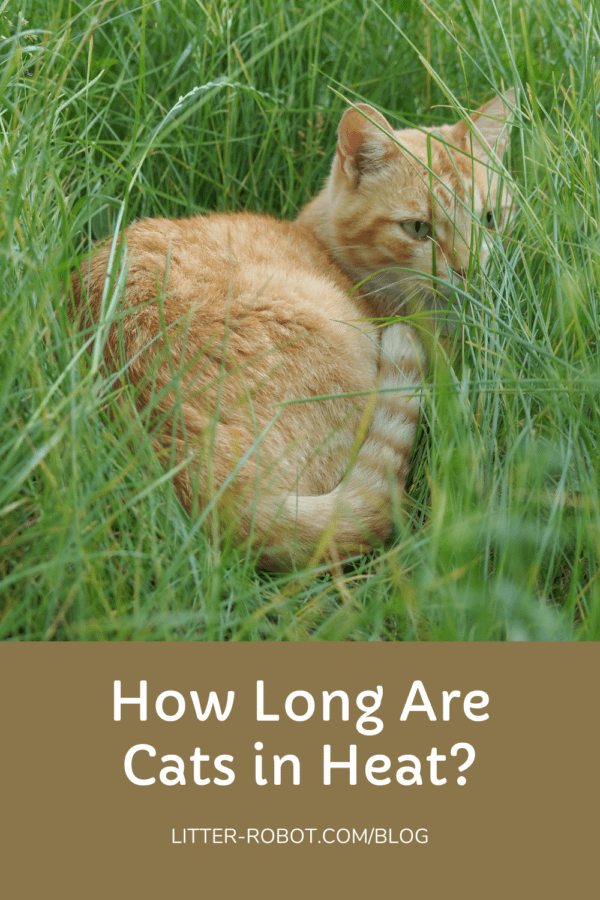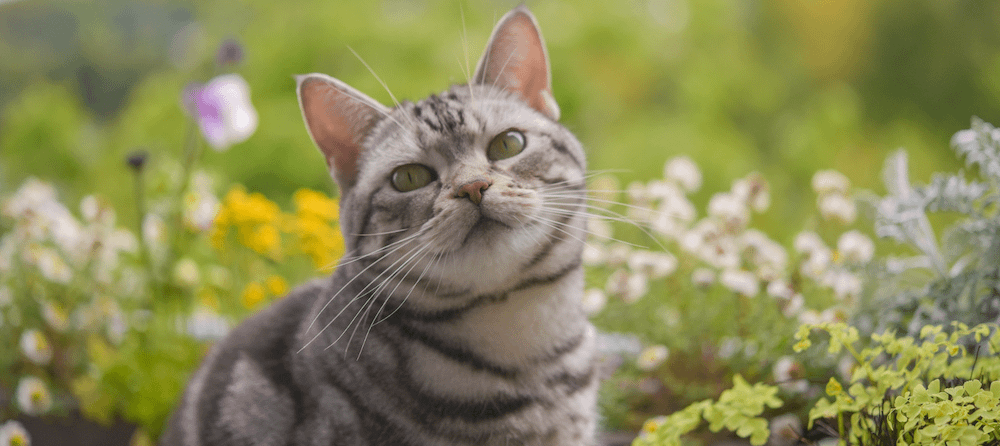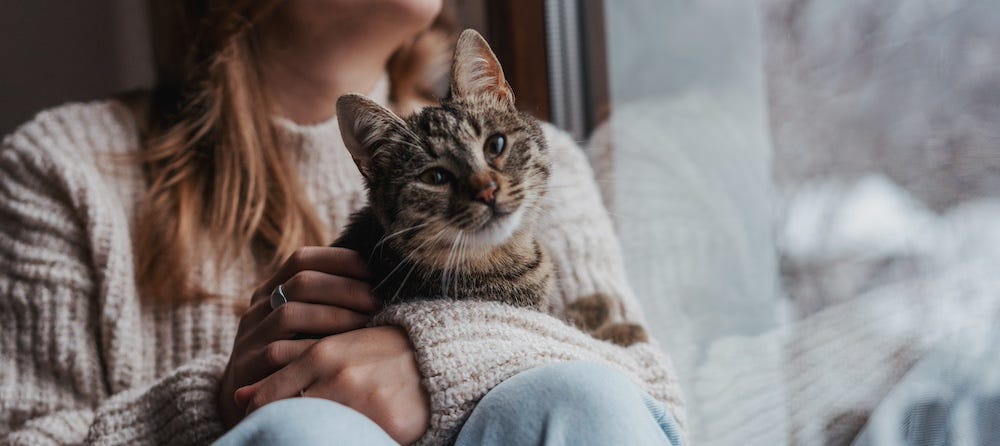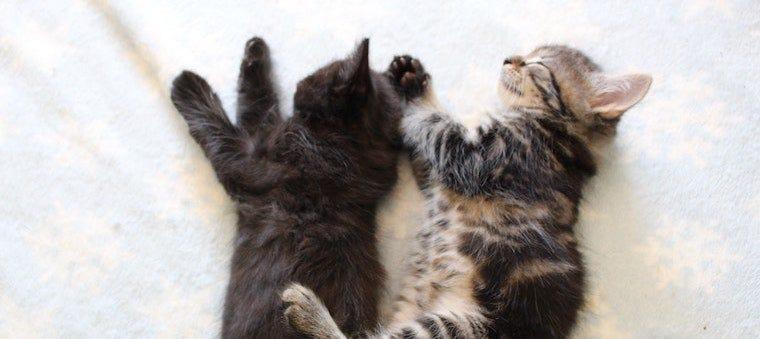If your female cat has not been spayed, or fixed, when she reaches puberty, she will have her first estrus or heat. Estrous, with an “o”, is an adjective used to describe the components surrounding and related to estrus. So what is the estrous cycle? It is also commonly known as a heat cycle or reproductive cycle, which happens when your cat has reached sexual maturity. Much like in humans, there’s a range for when cats may reach sexual maturity: for some their first heat can happen as early as 4 months old. On average, most female cats will have their first estrus around 6 months of age and the average length of time a female cat is in heat is approximately 7 days. However, it is not uncommon for a cat's heat cycle to last only 1 day, or even up to 3 weeks.
When your cat reaches the age of sexual maturity, they may begin to act differently— indicating that they might be in heat. Below, we’ll explore what to look for to determine if your cat is in heat and how you can help your cat throughout the process.
What is a cat heat cycle?
A heat cycle is the time from one heat event to the next heat event; it takes place when a female cat is sexually mature, fertile, and ready to mate with a male cat. This cycle typically begins between 4 and 12 months of age in felines. Heat occurs when your feline’s body is hormonally ready to be able to withstand a pregnancy. If you wish to prevent your cat from becoming pregnant, it is important to take her to the vet to get spayed when your vet deems it is safe. If not, you run the risk of your cat becoming pregnant.
How often are cats in heat?
Cats have multiple cycles during the breeding season. Your cat will go through the stages of heat—outlined below—and then the cycle will repeat itself every 2 to 3 weeks until the breeding season is over.
Cats are seasonally polyestrous. This means that depending upon geographic and environmental factors—like temperature and daylight hours—your cat's cycling season will last anywhere from spring to fall. Indoor cats tend to be sheltered from the light cycles of the sun; subsequently, they may not cycle as frequently as an outdoor cat would, but this can all be manipulated with lighting.
Signs your cat is in heat
While you might assume that cats’ cycles are similar to humans and the most obvious sign would be vaginal bleeding, you would be incorrect. In fact, vaginal bleeding from a cat in heat—or in general—should result in a trip to the veterinarian. Instead, you should be looking for the following signs that your cat is in heat:
- Unusually affectionate, rubbing
- Marking territory by spraying surfaces with urine
- Mating call: loud vocalization
- Mating position: head down, rear quarters and tail raised
- Excessive grooming
- Wanting to escape to the outdoors
- Loss of appetite
5 stages of feline heat cycle
Your female feline will go through 5 phases during her estrous cycle. While there are some notable behavioral changes during these stages, the best way to determine which stage your cat is in would be by working with your veterinarian. For day-to-day cat ownership, knowing the stages is not as important: this is more relevant for breeding.
Stage 1: Proestrus
During this stage, your female cat will begin to attract unneutered males, but she will not be receptive to mating. This typically lasts a day or two. She may have some swelling of her vulva in addition to increased vocalization and rubbing. It is not uncommon to not notice any changes in behavior these few days.
Stage 2: Estrus
In the estrus stage, the actual heat, your cat will begin to exhibit the behavioral changes mentioned above. During this stage, your cat will be receptive to mating with unneutered males. This phase lasts 5-7 days, but it can be shortened by mating or lengthened by not mating.
Stage 3: Diestrus
Cats only enter this stage if they mate and ovulation is induced. Because cats are induced ovulators and ovulation doesn’t happen automatically, it may take repeated matings for ovulation to occur. When your cat has ovulated, it is now in diestrus.
During ovulation, felines generally need to mate 4 to 6 times to become pregnant and can have several mates. It is even possible for your cat to give birth to a litter of kittens with different fathers. This is known as superfecundation.
This phase lasts for a while depending on whether a true pregnancy results or a fake one, or pseudopregnancy. For pseudopregnancies, diestrus may last 40-45 days and for true pregnancies, diestrus lasts 63-65 days.
Stage 4: Interestrus
If some form of pregnancy does not occur during diestrus, your cat will go into interestrus. This is the stage where her hormone level will drop and she will have no signs of heat. The interestrus stage lasts 8-9 days. Then your cat will go into heat again. These stages continue throughout the breeding season or until your feline becomes pregnant during diestrus.
Stage 5: Anestrus
The last stage during the heat cycle is anestrus. This stage is the absence of the heat cycle. It typically occurs when there are fewer daylight hours, like in the winter. Your cat will begin hormone production again when it is stimulated by light during longer daylight hours.
How can I support my cat in heat?
When your cat is in heat, you will likely know it. The yowling and constant need for affection can be overwhelming. But your cat will need your help and support to ease through the stress of the breeding season.
Spaying
If you do not want your cat to become pregnant and do not want them to have to go through heat cycles, you should consult your veterinarian or local Humane Society to inquire about options for spaying your cat. The surgery will prevent unwanted pregnancies and litters of kittens, helping control the overpopulation of cats. Additionally, the earlier you spay your cat, the more it decreases her chances of developing mammary tumors, or cancers of the breast tissue. Sexually intact cats have a seven-fold increased risk for mammary tumors compared to spayed cats.
Can you spay a cat while in heat?
It’s possible to spay a cat during her heat cycle, but most vets would not recommend it. Simply explained, when a cat is in heat, there’s more vasculature (e.g., blood vessels and blood flow) to the ovaries and uterus. That results in a more expensive, longer surgery, as the tissue is more delicate. Only in emergency medical situations will vets want to spay a cat in heat.
Avoid male cats
If you have unneutered male cats in your home, now is the time to keep them separated. Your female cat will grow more excitable around males and mating can lead to pregnancy. It may be best to consider fixing one or both of your intact cats so that mating is not an issue.
You should also ensure that your cat is safe inside, away from windows and doors so she does not try to escape. She will be searching for mates, and the isolation within your home will help keep her safe.
Comfort and stimulation
Your cat will likely need extra comfort, including extra petting and brushing. The attention can help ease the stress your feline is feeling. It’s also important to remember that some cats may prefer being alone, or even a mix of wanting to have attention and still needing places to escape. Cat furniture is a great solution that offers comfort, lounging, exercise, stimulation, and stretching—all in one! It’s an ideal place for your cat to escape to, while also providing the stimulation that she requires.
Catnip
Catnip can be a great resource to use, but only if it has a calming effect on your cat. Since each cat responds differently to catnip—either energetically or calmly—you should proceed with caution. If it generally calms your cat when not in heat, utilize catnip to help relax and quiet your cat. However, if your cat generally becomes energetic around catnip, it could make her even more stimulated.
Heat pack or towel
Having a warm pack or towel for your cat to sit on can help keep her calm and still. You can also use a heating pad on low or warm towels to ease any discomfort. Be careful to ensure that the heat source is not too hot so as not to burn your cat.
Can you stop your cat from going into heat mid-cycle?
Short of spaying your cat mid-cycle (which, again, vets do not recommend), you can't artificially stop your cat’s heat cycle. The best you can do is keep her indoors and away from unneutered male cats, so that mating will not occur.
Understanding your cat’s heat cycle
If your cat has not been spayed, you should continue to look out for the signs of the estrous cycle to help her through the process. Be sure to follow her cues to determine whether she needs more attention or more space. And be sure to have options for both calming environments and playful stimulation, like this rechargeable laser pointer.
If you do not want your cat to become pregnant, it is highly recommended that you spay your cat. Spaying cats is the most effective way to prevent cats from going into heat—and prevent pregnancies. Spaying is also healthier for your cat in the long run.
FAQs
How often do cats go into heat in a year?
Heat cycles repeat every 2 to 3 weeks and typically start in January and last through the fall, or until the cat becomes pregnant or is spayed.
Is estrus painful for cats?
No one can accurately say if estrus is painful for cats. However, their symptoms lead us to believe that they are likely uncomfortable. Do NOT give your cat any pain medications without consulting with your veterinarian for guidance.
What triggers a cat to go into heat?
A cat goes into heat based on sexual maturity and the timing of the seasons. Longer daylight hours that are filled with sunlight trigger your feline’s body to begin the estrus cycle.
Sources:
- Estrous Cycles in Cats
- Feline Pregnancy and Kitten Birth
- Normal feline reproduction: The queen
- Manipulation of the Estrous Cycle in Dogs and Cats







